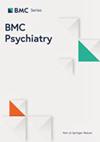对中国医学生睡眠状况指标测量特性和不变性的纵向研究
IF 3.4
2区 医学
Q2 PSYCHIATRY
引用次数: 0
摘要
睡眠状况指标(SCI)是一种失眠测量工具,基于最新的《精神疾病诊断与统计手册》第五版(DSM-5)标准,在不同人群中应用时具有良好的心理测量特性。这项两波纵向研究招募了中国某大学的医学生,他们在2022年9月至11月期间填写了简体中文版SCI(SCI-SC)、中文规律性、满意度、警觉性、定时性、效率性、持续时间量表(RU_SATED-C)、中国患者健康问卷-4(PHQ-4-C)和社会人口学变量问卷(Q-SV)。研究考察了 SCI-SC 的结构效度、测量不变性(MI)、收敛效度和判别效度、内部一致性和重测信度。我们对性别、年龄、家庭所在地、兼职工作、体育锻炼和压力应对策略等分组进行了两次调查,以检验横向和纵向的测量不变量。我们确定了 343 份有效答卷(62.9% 为女性,平均年龄 = 19.650 ± 1.414 岁),时间间隔为 7 天。双因素结构令人满意(比较拟合指数=0.953-0.989,Tucker-Lewis 指数=0.931-0.984,均方根近似误差=0.040-0.092,标准化均方根残差=0.039-0.054),除兼职工作亚组外,其他亚组大多具有严格不变性,因此建立了纵向不变性。SCI-SC 与 RU_SATED-C 量表的收敛效度(r ≥ 0.500)、与 PHQ-4-C 的区分效度(0.300 ≤ r < 0.500)、内部一致性(Cronbach's alpha = 0.811-0.835, McDonald's omega = 0.805-0.832)和测试-再测可靠性(类内相关系数 = 0.829)均可接受。SCI-SC是一种适用于评估医学生失眠症状的筛查工具,其良好的测量特性为检测医学生失眠的有效性和可靠性提供了更多证据。本文章由计算机程序翻译,如有差异,请以英文原文为准。
A longitudinal examination of the measurement properties and invariance of the Sleep Condition Indicator in Chinese healthcare students
The Sleep Condition Indicator (SCI), an insomnia measurement tool based on the updated Diagnostic and Statistical Manual of Mental Disorders, Fifth Edition (DSM-5) criteria with sound psychometric properties when applied in various populations, was evaluated here among healthcare students longitudinally, to demonstrate its measurement properties and invariance in this particularly high-risk population. Healthcare students of a Chinese university were recruited into this two-wave longitudinal study, completing the simplified Chinese version of the SCI (SCI-SC), Chinese Regularity, Satisfaction, Alertness, Timing, Efficiency, Duration (RU_SATED-C) scale, Chinese Patient Health Questionnaire-4 (PHQ-4-C), and sociodemographic variables questionnaire (Q-SV) between September and November 2022. Structural validity, measurement invariance (MI), convergent and discriminant validity, internal consistency, and test–retest reliability of the SCI-SC were examined. Subgroups of gender, age, home location, part-time job, physical exercise, and stress-coping strategy were surveyed twice to test cross-sectional and longitudinal MI. We identified 343 valid responses (62.9% female, mean age = 19.650 ± 1.414 years) with a time interval of seven days. The two-factor structure was considered satisfactory (comparative fit index = 0.953–0.989, Tucker–Lewis index = 0.931–0.984, root means square error of approximation = 0.040–0.092, standardized root mean square residual = 0.039–0.054), which mostly endorsed strict invariance except for part-time job subgroups, hence establishing longitudinal invariance. The SCI-SC presented acceptable convergent validity with the RU_SATED-C scale (r ≥ 0.500), discriminant validity with the PHQ-4-C (0.300 ≤ r < 0.500), internal consistency (Cronbach’s alpha = 0.811–0.835, McDonald’s omega = 0.805–0.832), and test–retest reliability (intraclass correlation coefficient = 0.829). The SCI-SC is an appropriate screening instrument available for assessing insomnia symptoms among healthcare students, and the promising measurement properties provide additional evidence about validity and reliability for detecting insomnia in healthcare students.
求助全文
通过发布文献求助,成功后即可免费获取论文全文。
去求助
来源期刊

BMC Psychiatry
医学-精神病学
CiteScore
5.90
自引率
4.50%
发文量
716
审稿时长
3-6 weeks
期刊介绍:
BMC Psychiatry is an open access, peer-reviewed journal that considers articles on all aspects of the prevention, diagnosis and management of psychiatric disorders, as well as related molecular genetics, pathophysiology, and epidemiology.
 求助内容:
求助内容: 应助结果提醒方式:
应助结果提醒方式:


